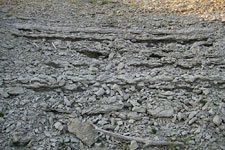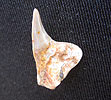|
The Geology of Texas - Vol. 1 |
|
| List from Geology of Tarrant County with updated names. Older names are in [brackets]. | |
| Pelecypods (oysters): Lopha subovata [Ostrea subovata] Rastellum carinatum [Ostrea sp.] Gryphea corrugata Say. Gryphea washitaensis Hill Inoceramus comancheanus Cragin Inoceramus munsoni Cragin Amphidonte walkeri [Exogyra americana] Trigonia sp. Pelecypods (scallops): Neithea texanus [Pecten texanus Roemer] Neithea subalpina [Pecten subalpina Boese] Neithea bellula [Pecten bellula Cragin] Neithea wrightii [Pecten wrighti Shumard] Pelecypods (clams): Pinna sp. Lima wacoensis Roemer Pholadomya sp. Gastropods: Turritella sp. Gyrodes sp. [?] Pleurotomaria austinensis Shumard. Fusus sp. Cerithium sp. Crania sp. Nerinea sp. Turbo sp. Tylostoma [Lunatia] |
Ammonites: Eopachydiscus [Desmoceras] Mortoniceras [Schloenbachia] Desmoceras-Pervinquieria ?? Oxytropidoceras (Adkinsites) diazi Ammonites (heteromorph): Idiohamites fremonti [Hamites] Hamites spp. Scaphites sp. Turrilites sp. Brachiopods: Waconella wacoensis [Kingena wacoensis] Kingena spp. Echinoids: Tetragramma [Diplopodia] Hemiaster whitei Clark Hemiaster sp. Holaster simplex Shumard. Macraster elegans [Hemiaster elegans Shumard] Goniophorus scotti Salenia sp. Arthropods: Callianassa sp. (crustacean burrows) Vertebrates: Fish teeth Shark teeth |
| Upper marl layers: | ||
 Location: Tarrant Co., TX. July 12, 2008. |
 Location: Tarrant Co., TX. May 10, 2009. |
 Location: Tarrant Co., TX. Sep. 26, 2009. |
| The limestone at the top could actually be the Fort Worth Formation instead. | ||
 Location: Tarrant Co., TX. Sep. 13, 2008. |
 Location: Tarrant Co., TX. Sep. 13, 2008. |
 Location: Tarrant Co., TX. Sep. 13, 2008. |
| Lowest limestone layers: | ||
 Location: Tarrant Co., TX. July 22, 2007. |
 Location: Tarrant Co., TX. March 4, 2007. |
 Location: Tarrant Co., TX. Sep. 7, 2009. |
 Location: Tarrant Co., TX. Dec. 15, 2013. |
 Location: Tarrant Co., TX. Dec. 15, 2013. |
 Location: Tarrant Co., TX. Dec. 15, 2013. |
| Cephalopods: (ammonites) | ||
unknown ammonite Location: Tarrant Co., TX. |
Eopachydiscus sp. Location: Tarrant Co., TX. |
Eopachydiscus sp. Location: Tarrant Co., TX. |
Mortoniceras sp. ammonite [+]
[+]Location: Tarrant Co., TX. |
Eopachydiscus and unknown Location: Tarrant Co., TX. |
Eopachydiscus and Mortoniceras sp. Location: Tarrant Co., TX. |
Idiohamites sp. Location: Tarrant Co., TX. |
unknown ammonite Location: Tarrant Co., TX. |
|
| Vertebrates: (sharks, fish) | ||
Leptostyrax macrorhiza? shark teeth Location: Tarrant Co., TX. |
various shark teeth Location: Tarrant Co., TX. |
(Paraisurus, Paraptychodus, 3 Cretalamna) Location: Tarrant Co., TX. |
Cretalamna appendiculata Location: Tarrant Co., TX. |
Paraptychodus washitaensis [+]
[+]Location: Tarrant Co., TX. |
Paraisurus [+]
[+]Location: Tarrant Co., TX. |
| Echinoids: (sea urchins, sea biscuits) | ||
Macraster washitae (top) Location: Tarrant Co., TX. |
Macraster washitae (bottom) Location: Tarrant Co., TX. |
Goniophorus scotti (top) Location: Tarrant Co., TX. |
Goniophorus scotti (bottom) Location: Tarrant Co., TX. |
Holaster simplex (top) Location: Tarrant Co., TX. |
Holaster simplex (bottom) Location: Tarrant Co., TX. |
| Gastropods: (snails) | ||
Gyrodes? [by Roz]
[by Roz] |
Gyrodes? [by Roz]
[by Roz] |
|
| Bivalves: (scallops, clams, oysters) | ||
Neithea texanus scallop Location: Tarrant Co., TX. |
Neithea texanus scallop Location: Tarrant Co., TX. |
|